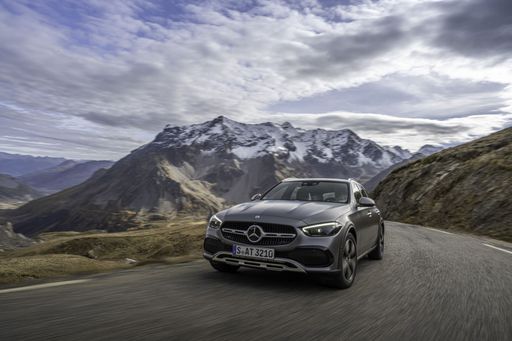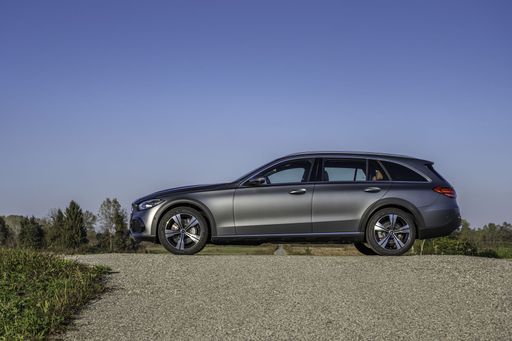Mercedes C-Class Wagon VS Renault Trafic Bus – Specs, Efficiency & Price Comparison
Which model is the better choice – the Mercedes C-Class Wagon or the Renault Trafic Bus? We compare performance (680 HP vs 150 HP), boot capacity (490 L vs ), efficiency (0.40 L vs 6.80 L), and of course, the price (42400 £ vs 38200 £).
Find out now which car fits your needs better!
The Mercedes C-Class Wagon (Estate) is powered by a Diesel MHEV, Petrol MHEV or Plugin Hybrid engine and comes with a Automatic transmission. In comparison, the Renault Trafic Bus (Bus) features a Diesel engine and a Manuel gearbox.
When it comes to boot capacity, the Mercedes C-Class Wagon offers 490 L, while the Renault Trafic Bus provides – depending on what matters most to you. If you’re looking for more power, you’ll need to decide whether the 680 HP of the Mercedes C-Class Wagon or the 150 HP of the Renault Trafic Bus suits your needs better.
There are also differences in efficiency: 0.40 L vs 6.80 L. In terms of price, the Mercedes C-Class Wagon starts at 42400 £, while the Renault Trafic Bus is available from 38200 £.
Compare all the key specs now and find out which model fits your lifestyle best!
Mercedes C-Class Wagon
The Mercedes-Benz C-Class Wagon offers a perfect blend of luxury and practicality, appealing to those who value both style and functionality in their vehicle. Its elegant design is complemented by a spacious and versatile interior, making it ideal for family trips or business travel. With advanced safety features and state-of-the-art technology, this estate car provides a driving experience that is both secure and enjoyable.
details @ group-media.mercedes-benz.com
@ group-media.mercedes-benz.com
 @ group-media.mercedes-benz.com
@ group-media.mercedes-benz.com
 @ group-media.mercedes-benz.com
@ group-media.mercedes-benz.com
 @ group-media.mercedes-benz.com
@ group-media.mercedes-benz.com
 @ group-media.mercedes-benz.com
@ group-media.mercedes-benz.com
Renault Trafic Bus
The Renault Trafic Bus is a versatile and spacious option for those needing to transport multiple passengers comfortably. With its modern design and practical features, it is well-suited for both business and leisure purposes. Its efficient engine and smooth handling make it a reliable choice for long journeys.
details

|
|
|
|
|
Costs and Consumption |
|
|---|---|
|
Price
42400 - 115300 £
|
Price
38200 - 51100 £
|
|
Consumption L/100km
0.4 - 9 L
|
Consumption L/100km
6.8 - 7.2 L
|
|
Consumption kWh/100km
-
|
Consumption kWh/100km
-
|
|
Electric Range
11 - 112 km
|
Electric Range
-
|
|
Battery Capacity
19.50 kWh
|
Battery Capacity
-
|
|
co2
11 - 206 g/km
|
co2
179 - 188 g/km
|
|
Fuel tank capacity
40 - 66 L
|
Fuel tank capacity
80 L
|
Dimensions and Body |
|
|---|---|
|
Body Type
Estate
|
Body Type
Bus
|
|
Seats
5
|
Seats
8 - 9
|
|
Doors
5
|
Doors
4
|
|
Curb weight
1755 - 2235 kg
|
Curb weight
2031 - 2321 kg
|
|
Trunk capacity
360 - 490 L
|
Trunk capacity
-
|
|
Length
4751 - 4842 mm
|
Length
5080 - 5480 mm
|
|
Width
1820 - 1900 mm
|
Width
1956 mm
|
|
Height
1454 - 1494 mm
|
Height
1973 - 1974 mm
|
|
Payload
440 - 565 kg
|
Payload
749 - 982 kg
|
Engine and Performance |
|
|---|---|
|
Engine Type
Diesel MHEV, Petrol MHEV, Plugin Hybrid
|
Engine Type
Diesel
|
|
Transmission
Automatic
|
Transmission
Manuel
|
|
Transmission Detail
Automatikgetriebe
|
Transmission Detail
Schaltgetriebe
|
|
Drive Type
Rear-Wheel Drive, All-Wheel Drive
|
Drive Type
Front-Wheel Drive
|
|
Power HP
186 - 680 HP
|
Power HP
110 - 150 HP
|
|
Acceleration 0-100km/h
3.4 - 8.8 s
|
Acceleration 0-100km/h
13.6 - 16.5 s
|
|
Max Speed
226 - 280 km/h
|
Max Speed
161 - 174 km/h
|
|
Torque
250 - 1020 Nm
|
Torque
300 - 350 Nm
|
|
Number of Cylinders
4
|
Number of Cylinders
4
|
|
Power kW
137 - 500 kW
|
Power kW
81 - 110 kW
|
|
Engine capacity
1496 - 1999 cm3
|
Engine capacity
1997 cm3
|
General |
|
|---|---|
|
Model Year
2024 - 2025
|
Model Year
2023 - 2024
|
|
CO2 Efficiency Class
D, G, E, F, B
|
CO2 Efficiency Class
G
|
|
Brand
Mercedes-Benz
|
Brand
Renault
|
Mercedes C-Class Wagon
Introduction to the Mercedes-Benz C-Class Wagon
The Mercedes-Benz C-Class Estate, more popularly known as the T-Modell, represents a striking blend of luxury, practicality, and advanced automotive technology. This vehicle is tailored for those who require the elegance and sophistication typical of Mercedes-Benz, while also needing versatility and space. In this article, we will delve into its technical prowess and innovative features that make it a standout in the automotive world.
Powertrain and Performance: A Range to Impress
The C-Class T-Modell offers a diverse range of engine options designed to cater to various driving preferences. From the efficient diesel mild-hybrid powertrains, delivering impressive torque and fuel efficiency, to the robust petrol mild-hybrid models, the C-Class Estate is equipped to handle various driving demands. The plug-in hybrid variants provide exceptional electric-only ranges, boasting up to 113 km on a single charge, making it a suitable companion for both city commutes and longer journeys.
Innovative Mild-Hybrid Technology
Mercedes-Benz integrates its cutting-edge mild-hybrid technology across multiple models within the C-Class Estate range. This system utilises a powerful battery and starter-generator motor to assist the internal combustion engine. This results in smoother acceleration, reduced fuel consumption, and lowers emissions, all contributing to an efficient yet dynamic driving experience.
Dynamic Handling and Driveability
Equipped with an advanced 9-speed automatic transmission, the C-Class T-Modell offers seamless gear changes and optimised driveability, ensuring both comfort and performance are prioritised on the road. Drivers have the flexibility to choose between rear-wheel drive for a classic driving experience, or the 4MATIC all-wheel drive for added stability and traction, ideal for diverse weather conditions and terrains.
Luxurious Interior and Advanced Features
Inside, the C-Class Estate is crafted to offer unparalleled luxury and technological innovation. Prominent features include the MBUX multimedia system with voice control, a large central display screen, and optional augmented reality navigation, which collectively enhance the driving experience. The cabin is spacious, with a generous load volume making it perfect for family outings or business trips, while the premium materials and sophisticated design reflect Mercedes-Benz’s commitment to luxury.
Safety and Driver Assistance Systems
As expected from a brand renowned for safety, the C-Class T-Modell comes equipped with an array of safety and driver assistance systems. Adaptive cruise control, lane-keeping assist, and a host of other intelligence-based systems are designed to protect occupants while reducing driver fatigue, making each journey safer and more comfortable.
Conclusion
The Mercedes-Benz C-Class Estate stands as a testament to innovation in automotive design, marrying luxury with practicality. Its variety of powertrains, cutting-edge technology, and focus on safety make it a compelling choice for those seeking a versatile yet sophisticated car. Whether for long distances or daily city drives, the C-Class T-Modell delivers a driving experience that is both engaging and effortlessly efficient.
Renault Trafic Bus
A Glimpse into the Renault Trafic Bus: An Icon of Versatility and Innovation
Amongst the plethora of vans designed for both business and leisure, the Renault Trafic Bus stands out as an exemplar of functionality, innovation, and style. Let's delve into what makes the Renault Trafic Bus a popular choice in the UK and across Europe, particularly focusing on its technical specifications and state-of-the-art features.
Performance Dynamics: Power Under the Hood
The Renault Trafic Bus, a staple in Renault's fleet, is driven by a robust diesel engine configuration with power outputs ranging from 110 PS to a formidable 170 PS. The diesel engines combine efficiency and power, offering torque figures between 300 to 380 Nm, ensuring smooth power delivery and capable load hauling.
Drivers can choose between manual and automatic transmissions, both designed to complement the Trafic's front-wheel-drive system. This flexibility ensures that drivers experience enhanced driving comfort whether they are navigating urban roads or cruising on the motorway.
Efficiency Meets Economy
The Trafic Bus showcases impressive fuel economy with consumption figures ranging from 6.8 to 7.2 litres per 100 kilometres. This efficiency is crucial for businesses aiming to minimise operational costs and for families seeking budget-friendly travel options.
With a generous fuel tank capacity of 80 litres, the Renault Trafic Bus is built to cover long distances with fewer fuel stops, making it an ideal choice for long haul journeys.
Technological Innovations and Comfort
The Trafic Bus isn't just about robust performance. Renault has integrated a suite of technological innovations designed to enhance driver and passenger comfort. Its cabins are equipped with the latest infotainment systems and safety technologies, providing an optimal blend of comfort and convenience.
The various trims, such as Life, Start, Spaceclass, and their respective EDC variants, cater to different needs and preferences, ensuring that customers can find the perfect configuration for their requirements.
Design and Dimensions: Space for Every Purpose
Space and versatility are at the heart of the Trafic Bus design. With its dimensions ranging from a length of 5080 to 5480 mm, and a width of 1956 mm, this vehicle offers ample room for passengers and cargo alike. The height stands between 1973 and 1974 mm, ensuring that even taller individuals can travel comfortably.
With seating for up to eight people and a payload capacity between 730 to 1010 kg, the Trafic Bus can transform seamlessly between a people-mover and a goods carrier.
Environmental Considerations
Renault has engineered the Trafic Bus with environmental responsibility in mind. The CO2 emissions range from 178 to 190 g/km, which, while modest for its class, aligns with the efficiency and performance goals set for this versatile vehicle. The CO2 efficiency class is rated as 'G', offering transparency in its environmental impact profile.
Conclusion: A Leader in Its Class
The Renault Trafic Bus continues to lead its segment through a blend of power, efficiency, and technological advancements. Whether it's for commercial transport or family adventures, the Trafic offers a reliable and adaptable solution, setting a high standard for multi-purpose vehicles.
For those seeking a distinguished blend of utility and comfort, the Renault Trafic Bus emerges as an exceptional choice, promising performance and innovation on every journey.
The prices and data displayed are estimates based on German list prices and may vary by country. This information is not legally binding.
